Kiwi Ears Cadenza Review
By Nick Smith, 25th Februrary 2023
From time to time a product of universal appeal with a paltry price tag comes along, leading many of us to furrow our brows over reasons not to recommend it. After all it is the responsibility of the reviewer to present a balanced perspective without the appearance of bias, but how can we do that when the product in question is seemingly without any of the major drawbacks one associates with this price range? You can see the dilemma.
Having recently delved back into the world of entry-level IEMs, a YouTube review alerted me to the Cadenza’s existence. After living with them for weeks I now find myself in an existential audiophile crisis, questioning past & future purchases from a value perspective. Which is not to say the Cadenzas are perfect, or I could happily daily drive them indefinitely, But so much for so little shakes up my audiophile mental landscape – bringing with it renewed memories of the Sonic Impact T-amp!
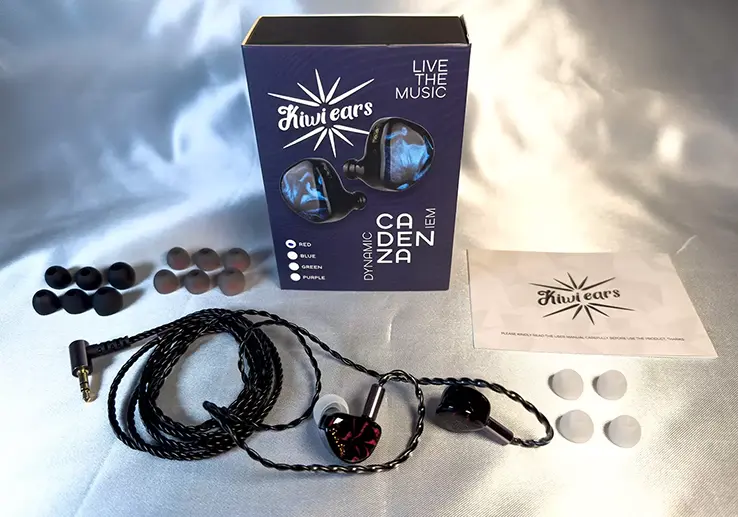
The Cadenzas are a USD $35 set of 10mm beryllium-coated, single dynamic driver IEMs which I purchased from Linsoul here.
Inside the small, no-frills cardboard box is a single ended 3.5mm cable any experienced Head-Fier will know better than to use, three sets of eartips of dubious usefulness, some words printed on paper I quickly discarded, and the IEMs themselves. The Cadenzas are available in a choice of four colours, I chose red.
I’m not a fan of lavish unboxing experiences knowing my money is being spend on accessories I’ll never use and a heavy box that will cost a fortune to ship. So I heartily approve of Kiwi Ears’ approach, funnelling the lion’s share of manufacturing costs into what actually matters – the IEMs.
Speaking of them, my first impression of handling the Cadenzas was how unexpectedly premium they look and feel. It will sound trite, but I’d never in a million years have guessed these are a $35 set of earphones. Not only do they feel extremely smooth against the skin but the shells are as comfortable as any earphones in my possession, though the IE600s I recently sold would’ve taken that crown.
Sound Impressions
Simply put, almost universally favourable. I hear the Cadenzas as having a neutral tuning with tastefully lifted sub bass. They’re fairly energetic but I wouldn’t call them bright, the midrange is present enough to perform well with male & female vocals, treble is sufficiently vivid to represent classical music acceptably, and though these are by no means bass cannons I do find them offering enough down low to be very enjoyable with electronic music.
What surprised me mostis just how fast these dynamic drivers are, something I’d never have expected for $35. There is no sluggishness here, and I can’t recall a time they struggled to articulate their way through busy passages of music as is often the case with budget single-DD IEMs.
One minor quibble is tonality, where I feel they are not the most natural sounding DD I’ve heard. I wouldn’t label them as possessing a metallic sheen, but rather having a slight tendency in that direction – halted before going so far as to render them unenjoyable. My only other gripe is bass impact isn’t something they do as well as other single-DDs (especially in higher price brackets) perhaps as a tradeoff in exchange for raw driver speed.
Their technicalities are as good or better than other budget single-DDs in my collection, absolutely not so inferior that my enjoyment of the music is infringed, but conversely their technical chops rarely call attention to themselves. The soundstage is perfectly adequate but not huge, imaging & separation are fairly middling, although detail retrieval is quite good for a single driver.
The Cadenzas stand out as doing very little wrong with any genre I throw at them, without sounding veiled or “boring” like some IEMs known as all-rounders. (ie. U12T)
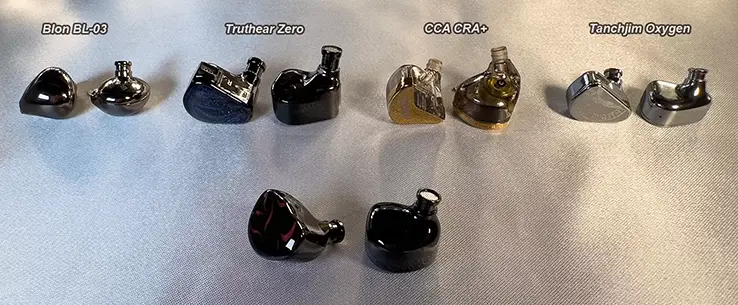
IEM Comparisons
The Cadenzas were pitted against my collection of budget DD IEMs, using my very-much-not-so-budget Cayin N8ii. The DAP was put into Class A, Solid State, P Mode with High Gain activated as this is the configuration I find most transparent. Local FLAC & DSD files were played from a Micron micro-sd card.
CCA CRA+ ($27)
I used a volume of 27 on the N8ii for the CRA+, compared with 28 for the Cadenzas so they’re similarly easy to drive. The CRA+ I purchased last year, and until the Cadenzas arrived were the best value IEM’s I’d ever heard. It’s amazing how slow and sluggish they now sound by comparison, although to be fair their sub bass does decay with more visceral rumble, but slightly less impact.
CRA+ dynamics may be a touch better than those of the Cadenza, and with a stronger lower-frequency emphasis I find they can sometimes represent male & female vocals with more body. Having said that the Cadenzas feel much better balanced with a slightly broader stage, and are infinitely faster, doing better with more genres. The CRA+ are also larger, made of cheap plastic and significantly less comfortable than the Cadenzas for longer listening sessions.
Tanchjim Oxygen ($270)
With an N8ii volume of 27 the Oxygens sound much more open than the Cadenzas, though I suspect this is a reflection of the difficulty I have achieving a tight seal with their unusually tiny shells. They seemed to possess warmer air betwen instruments and slightly fuzzier imaging as a result, with a slight upper frequency emphasis. Notes had less bite & attack, and the rounded presentation extended down to the sub bass which hit with less impact than the Cadenzas, but perhaps a tad more rumble.
Generally I found the Cadenzas to be slightly more holographic and resolving, and have never been a fan of the Oxygens though they are very non-fatiguing. They’re also a reminder spending more money in this hobby doesn’t automatically equate to “better” sound.
Blon BL-03 ($27)
Requiring only 25 on the N8ii, the BL-03s are legendary budget-friendly IEMs that are still going strong. They possess deeper (but more bloated) sub bass than the Cadenzas, with a more present lower midrange and a smoother organic tonality. Unfortunately their soundstage is more congested and imaging is also poorer, with the Cadenzas being faster, slightly more resolving and having more sub bass impact. I still regard the BL-03s as a solid purchase, finding them extremely comfortable.
Truthear x Crinacle Zero ($50)
Harder to drive at 30 on the N8ii, the Zeros possess dual dynamic-drivers. They have a more laidback presentation with a wider soundstage that appeared more spread out in front of the listener, as opposed to the Cadenza’s feeling wrapped around the head. The Zeroes are somewhat more muted in the upper frequencies, but as a result delivered a very smooth sound with slightly more lower midrange presence.
Zero bass definitely goes deeper than Cadenza’s, with more texture and authority. Cadenzas are more upfront in their vocal presentation and deliver greater resolution, with what I feel is a more lively and engaging sound. However the smoother Zero’s may be a better choice for harsh, poorly-mastered music.

Source Comparisons
I was curious to know how the Cadenzas responded to different sources, here are those findings.
3.5mm Apple Lightning Dongle ($10)
The Cadenzas were listenable and even enjoyable from the Apple dongle (in the way a cheap car stereo can be) but did not deliver what I consider audiophile sound. The presentation was fairly muddy, with a narrow soundstage & very muddled separation. Dynamics were poor and everything sounded veiled.
iFi Go Bar Anniversary Edition ($500)
Both the Go Bar & SR25 proved a massive step up from the Apple Dongle. Surprisingly for such a tiny device, the Go Bar delivered slightly higher resolution than the SR25, but sounded slightly less punchy. The Go Bar also had a slightly narrower stage, with a marginally less-warm tonality but a bit more treble sparkle. The Go Bar’s biggest sonic disadvantage is an appreciably higher noise floor than the other sources.
Astell & Kern SR25 ($600)
Offering deeper bass and a slightly wider stage than the Go Bar, it was easier to make out the trailing echoes of notes on the SR25. Nuances in the throats of vocalists and the sound of their breathing were also more apparent on the SR25, despite the Go Bar somehow maintaining the impression of greater resolution perhaps due to increased treble emphasis. The Cadenzas and the SR25 were an extremely satisfying pairing.
Cayin N8ii ($3500)
The N8ii offered increased naturalness over the previous two sources, providing a smoother, more analgoe presentation without sacrificing any detail. The Go Bar in particular sounded noticeably more digital or artificial by comparison. The N8ii also demonstrated better dynamics, better separation, and maintained control during busy passages more easily. It provided a more refined, effortless sound that was freer of harshness and glare, a slightly wider stage and deeper sub bass with perhaps a touch more resolution. Having saying all that, these differences were actually quite subtle (at least when heard through the Cadenzas) and a much higher-end IEM would be needed to justify the n8ii’s significant expense. The Cadenzas were however resolving enough to reveal those differences.
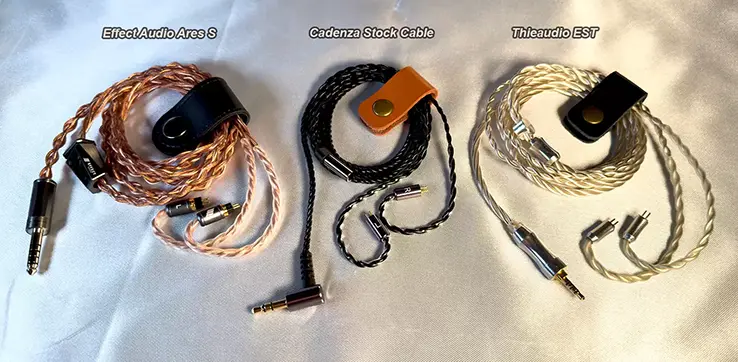
Cable Comparisons
Cables sound different and if you believe otherwise you’re in the wrong place. I made these comparisons on the N8ii in AB Mode with Tube activated, with High Gain and P+ engaged, as this is the configuration I find most satisfying for dynamic drivers.
Stock Cable
Useful for non-audiophiles who have nothing better. Ergonomics are fine and it seems well-enough made for a cheap stock cable, but (as expected) it delivered a muted presentation with poor dynamics, a compressed soundstage, and notes that lacked impact. Sad to think many Cadenza owners will use it, leaving so much room for improvement on the table.
Thieaudio EST ($70)
An unfair comparison, given both the EST & Ares S are balanced cables and many portable sources use different amp sections for balanced & unbalanced jacks – often with more power & quality on the balanced side, often making balanced cables instant improvements. The EST is a basic 4 core OCC silver-plated litz cable that delivered a leaner sound compared with the Ares S, with marginally more upper midrange but a slightly narrower stage. (yet still larger than stock)
Effect Audio Ares S ($180)
The Ares S had more lower midrange presence, a slightly wider stage & deeper sub bass. Music flowed a little easier and sounded a touch more analogue. Both cables improved Cadenza’s performance in different ways, with Ares S making it sound a little earthier and EST imparting more sheen and upper frequency sparkle.
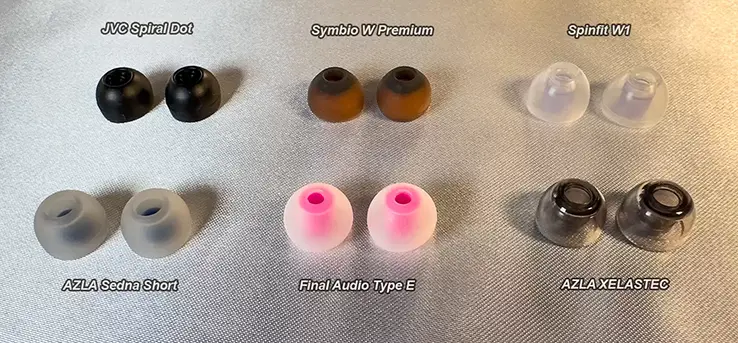
Eartip Comparisons
Eartips can change an IEM’s presentation substantially and I’ve built quite a collection. Here are my findings, but do bear in mind the performance of eartips will depend on how they fit your ear canals so experimentation with a wide assortment is recommended.
AZLA Xelastec
I find their sticky texture awkwardly discomforting. They delivered slightly less bass impact than some alternatives, with a somewhat narrower soundstage, affecting something of a tunnel effect in the midrange that I found fatiguing.
Spinfit W1
I won’t disguise these being my current favourites and possibly best audio purchase in years. Not only are they close to the most comfortable, but somehow achieve the best seal of any tips I’ve tried – providing a massive boost to sub bass rumble I would never have believed possible. They do make the upper midrange seem to come forward slightly, and deliver a pristine clarity I can’t get enough of.
Symbio W
These have never pleased me, the larger sizes are simply too firm & huge to use comfortably and the biggest size that’s bearable usually seals poorly, resulting in most of the bass disappearing. Though I normally use size L tips, with Symbios I can’t use larger than a medium without significant discomfort.
JVC Spiral Dot
Once my previous favourites and still supremely soft, Spiral Dots emphasise treble and deliver a broad stage with instruments coming more from behind my ears than in front of them. Unfortunately they provide far less bass than W1s, but are definitely on par in comfort.
Final Audio Type E
Hugely comfortable with very good bass, yet not as much sub bass as W1s by some margin, and with a narrower stage than Spiral Dots. I find Type Es provide more of a midbass emphasis which I don’t always want.
AZLA SednaEarfitLight Short
These seal extremely well and provide great bass, though again less sub bass than W1s. Imaging felt very well defined as a reflection of the strong seal, but being slightly firmer they are not as comfortable as Type Es, and further behind Spiral Dots & W1s. Sonically probably my second favourite tips behind W1s.
Conclusion
Congratulations, you made it this far. Thanks for reading.
There is little more to be said except that if you don’t own a pair of Kiwi Ears Cadenzas you risk little by purchasing them, and will very likely be pleased for doing so. They’re one of the easiest audio products to recommend I’ve come across in over 20 years in the hobby.
Are they perfect? Of course not, nothing is. However they’re inoffensively pleasing without being excessively polite or boring, work well with every genre I’ve tried, and feel far better built than any $35 earphone has a right to be. In fact I’ve had some downright thrilling listening sessions with them lasting hours at a stretch, and my ears are no stranger to IEMs literally a hundred times more expensive.
Where on earth is this hobby going? You do have to wonder when a measly $35 can purchase sound of this quality, assuming you provide a balanced cable and a decent source. I for one welcome our new budget IEM overlords!

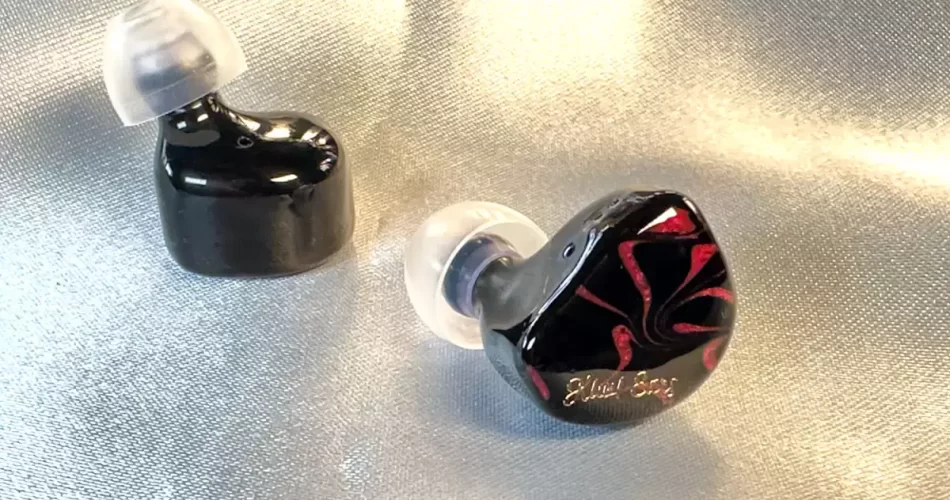
Comments